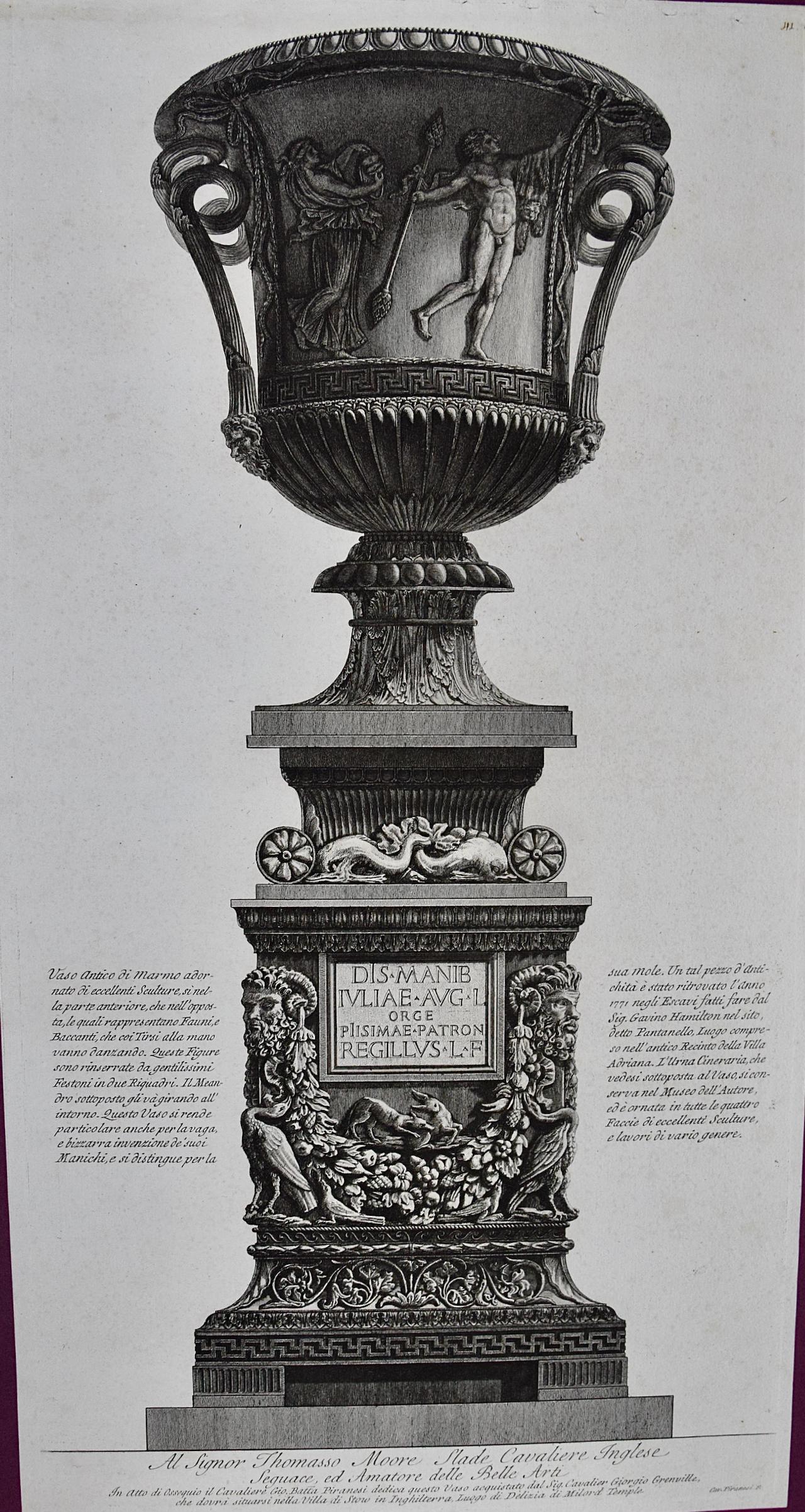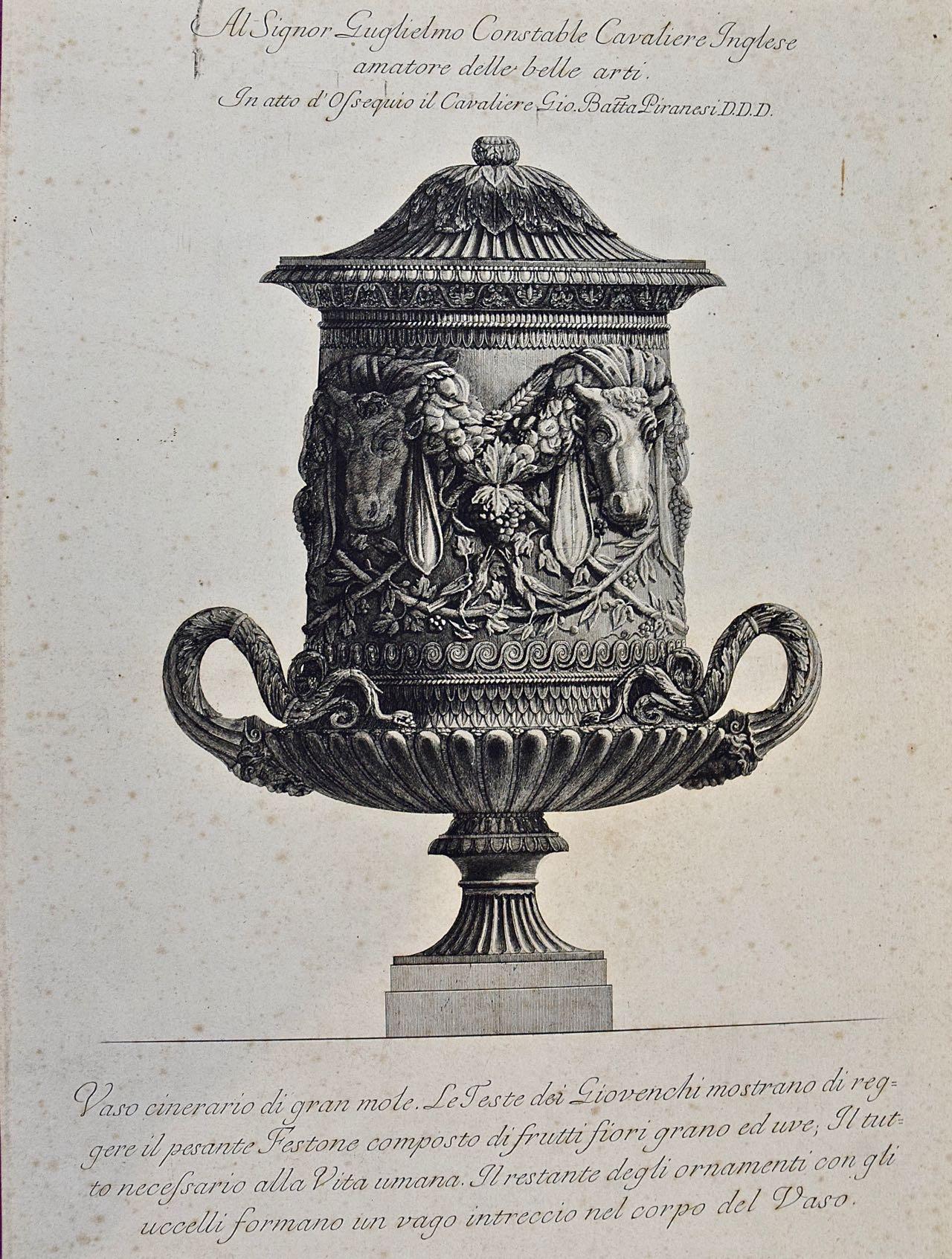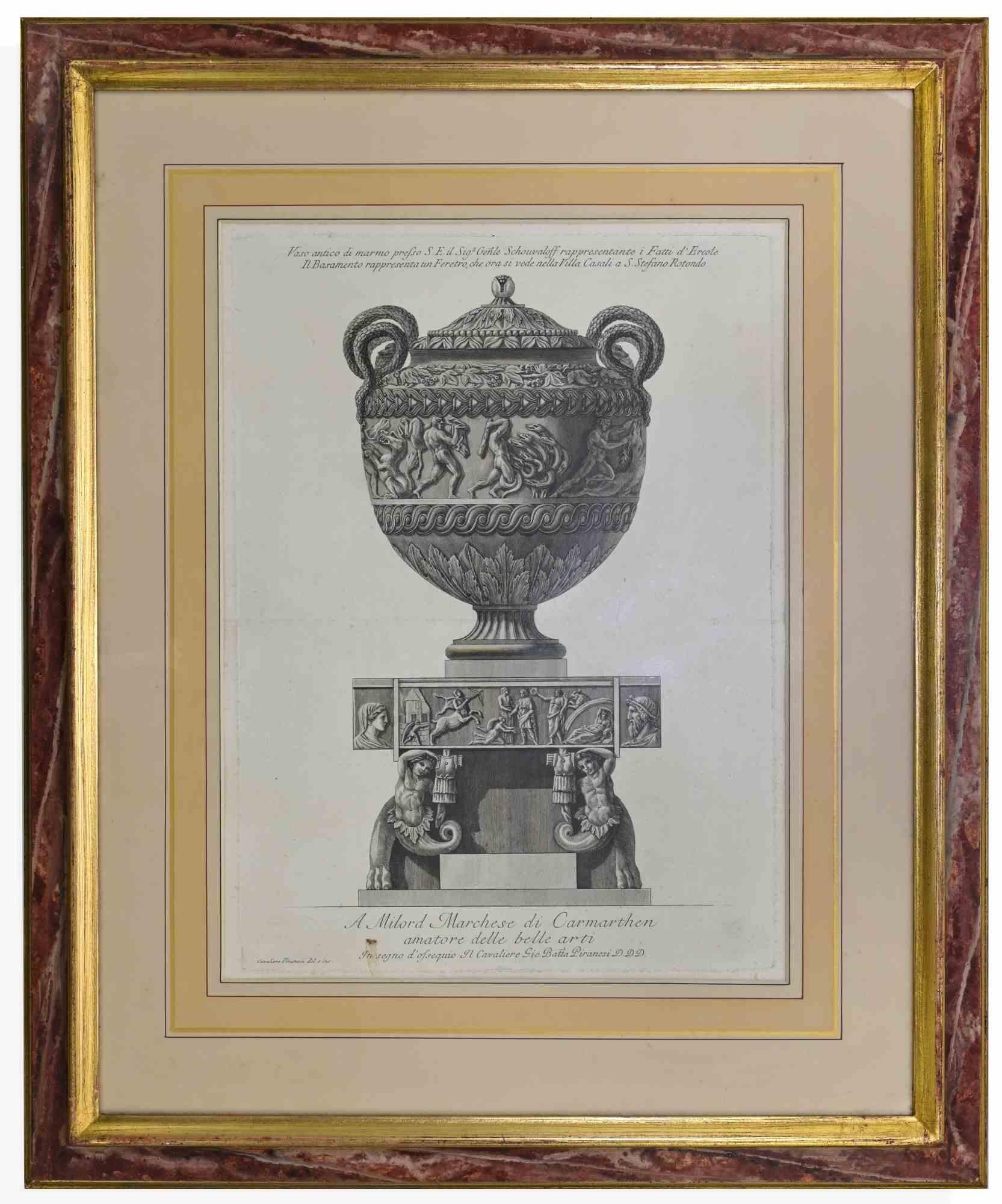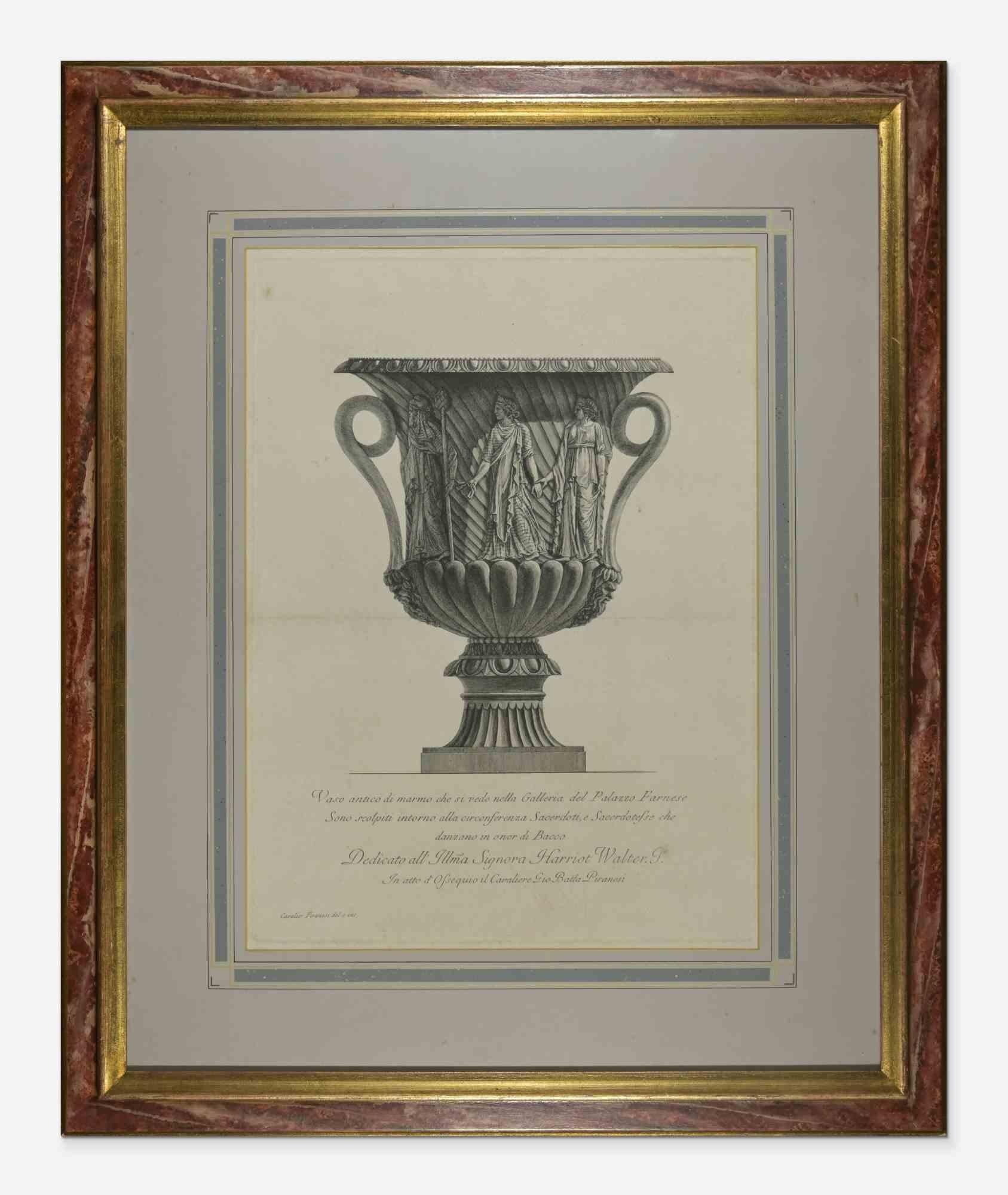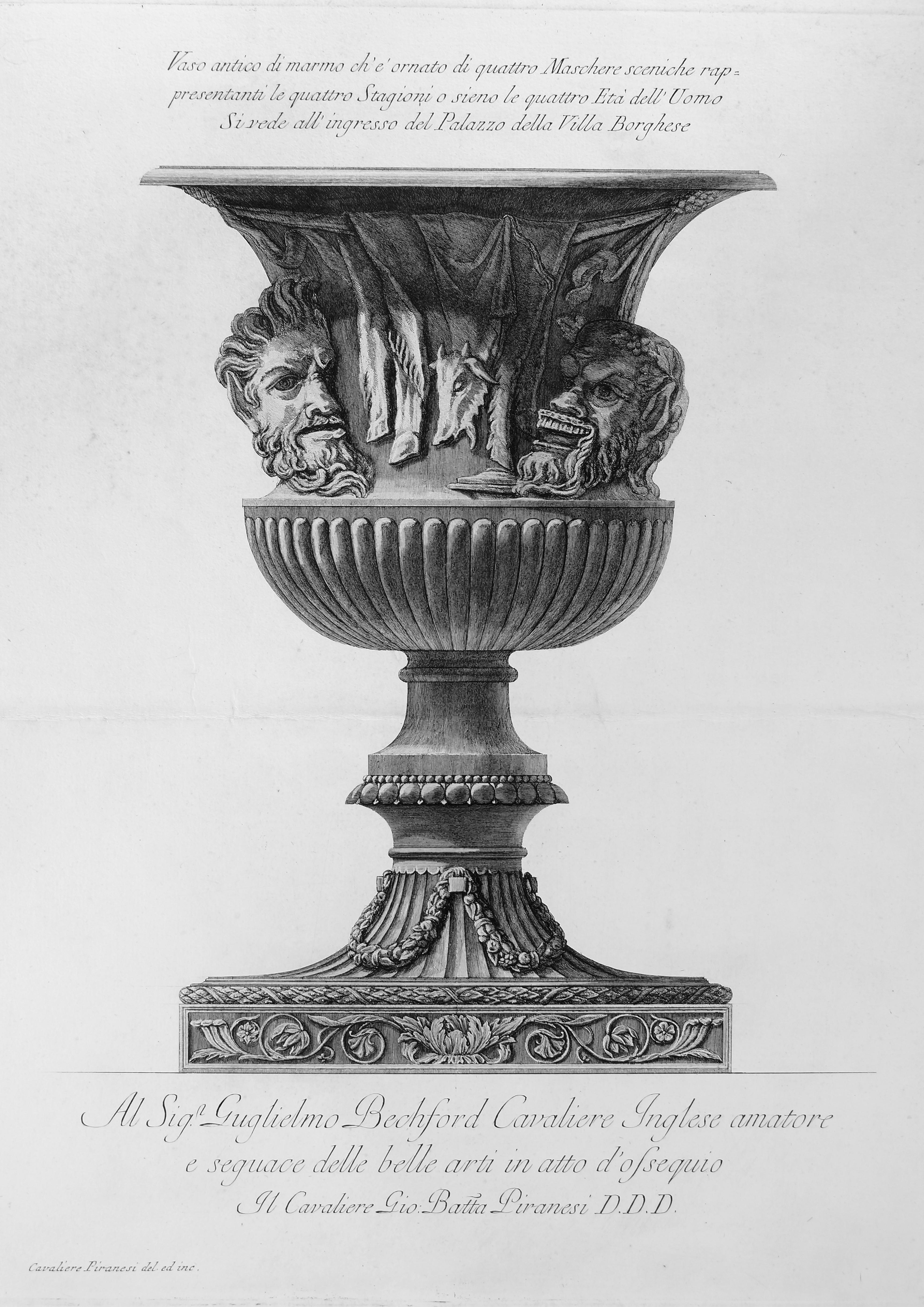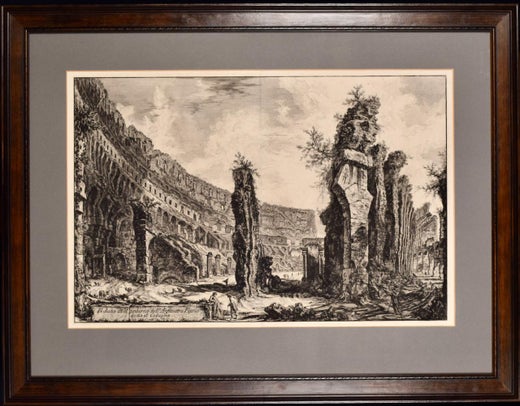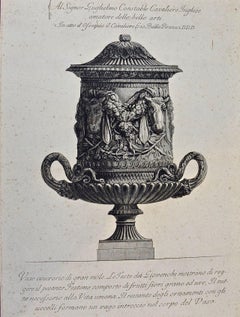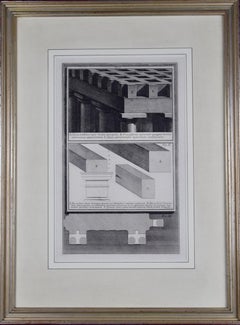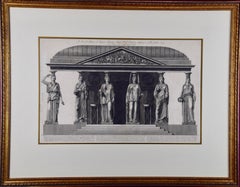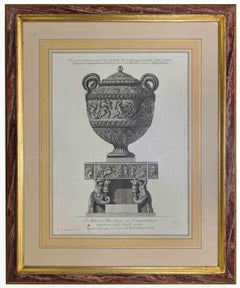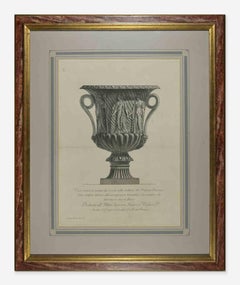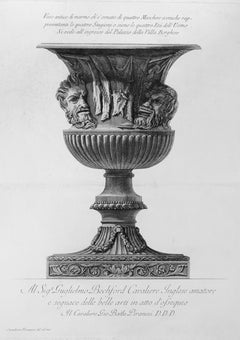Items Similar to A Framed 18th C. Piranesi Etching of an Ancient Marble Vase from Hadrian's Villa
Want more images or videos?
Request additional images or videos from the seller
1 of 9
Giovanni Battista PiranesiA Framed 18th C. Piranesi Etching of an Ancient Marble Vase from Hadrian's Villa1778
1778
$3,975
£2,951.23
€3,438.99
CA$5,518.58
A$6,172.88
CHF 3,212.40
MX$75,990.29
NOK 40,868.44
SEK 38,342.66
DKK 25,658.30
Shipping
Retrieving quote...The 1stDibs Promise:
Authenticity Guarantee,
Money-Back Guarantee,
24-Hour Cancellation
About the Item
This large framed 18th century etching by Giovanni Battista Piranesi is entitled "Vaso antico di Marmo adornato di eccellenti Sculture si nella parte anteriere che nell' opposta, le quail rappresentano Fauni e Baccanti" (Marble vase with a frieze of fauns), was published in Rome in 1778, as plate 41 from Piranesi's monumental work "Vasi, Candelabri, Cippi, Sarcofagi, Tripodi, Lucerne ed Ornamenti Antichi" (Studies of Vases, Candelabra, Funerary Monuments, Sarcophagi, Tripods, Lamps and Ancient Ornaments). It depicts an ancient Roman marble cinary vase and pedestal from Hadrian's Villa in Rome. The inscription at the bottom of the etching reads: "Al Signor Thomasso Moore Slade Cavaliere Inglese Seguace, ed Amatore delle Belle Arti", which roughly translates: To Mr. Thomasso Moore Slade English Knight, Follower, and Lover of Fine Arts.
This magnificent etching is printed on heavy laid, chain-linked paper. It is presented in an impressive ornate gold-colored wood frame and a cream-colored French mat with a medium cream-colored central band and gold and black thin bands. It is glazed with UV conservation glass. The frame measures 42.5" high by 26.5" wide by 1.5" deep. There is a central horizontal fold, as issued. There are a few faint spots, but the print is otherwise in very good condition.
This kind of vase is known as a Medici vase, which were initially produced in Athens in the first century AD for the Roman market. Piranesi personally restored many of these architectural objects and sold them to 18th century collectors, many of whom were tourists coming to Italy during the years of the Grand Tour who would bring them back to their home countries. Piranesi began collecting, restoring and selling ancient architectural objects in the 1760's in partnership with Thomas Jenkins and Gavin Hamilton, who had financed numerous excavations in the Pantanello area of Hadrian’s Villa at Tivoli. In 1768 Piranesi began creating etchings depicting these objects. The plates were eventually published together as a set in 1778 in "Vasi, Candelabri, Cippi, Sarcofagi, Tripodi, Lucerne ed Ornamenti Antichi". Piranesi dedicated many of the plates to patrons, colleagues, good customers and influential people. Many of the antiquities shown in Vasi were eventually sold to King Gustav III of Sweden by Piranesi's son, Francesco Piranesi, after his father’s death, and now reside in the National Museum in Stockholm.
Piranesi was born in Venice in 1720 and died in Rome in 1778. He was the son of a stone mason and was trained as an architect. After a slow start he eventually achieved great success as an architect, archaeologist, artist, designer, collector, and antiquities dealer. His mission was to glorify the architecture of ancient Rome through his engravings and etchings. His highly dramatized prints often depict imaginary interiors and frequently include figures in mysterious activities, who are dwarfed by the magnitude of their monumental surroundings. Piranesi was knighted by the Pope in 1765 and he was elected a Fellow of the Society of Antiquaries in England in 1757. Piranesi's style greatly influenced the neoclassical art movement of the late 18th century. His dramatic scenes inspired generations of set designers, as well as artists, architects and writers. His prints have continued to increase in value to institutions and collectors.
This etching is held by several museums and institutions, including the British Museum and The Metropolitan Museum of Art in New York and the Portland Art Museum.
References:
Hind, Arthur M. Giovanni Battista Piranesi : A Critical Study with a List of His Published Works and Detailed Catalogues of the Prisons and the Views of Rome. London: The Cotswold Gallery, 1922. pp. 86 (Diverse Manieri), 87 (Vasi).
Wilton-Ely, John. Giovanni Battista Piranesi: The Complete Etchings. San Francisco: Alan Wofsy Fine Arts, 1994. 2 volumes. Chapter F.II. Volume II. pp. 886-960, numbers 815-887 (Diverse Manieri); pp. 961-62, (Vasi).
- Creator:Giovanni Battista Piranesi (1720-1778, Italian)
- Creation Year:1778
- Dimensions:Height: 42.25 in (107.32 cm)Width: 26.5 in (67.31 cm)Depth: 1.5 in (3.81 cm)
- Medium:
- Movement & Style:
- Period:1770-1779
- Condition:
- Gallery Location:Alamo, CA
- Reference Number:Seller: # 47721stDibs: LU117329854962
Giovanni Battista Piranesi
Piranesi was born in Venice in 1720 and died in Rome in 1778. He was the son of a stone mason and was trained as an architect. After a slow start he eventually achieved great success as an architect, archaeologist, artist, designer, collector, and antiquities dealer. His mission was to glorify the architecture of ancient Rome through his engravings and etchings. His highly dramatized prints often depict imaginary interiors and frequently include figures in mysterious activities, who are dwarfed by the magnitude of their monumental surroundings. Piranesi's style greatly influenced the neoclassical art movement of the late 18th century. His dramatic scenes inspired generations of set designers, as well as artists, architects and writers. His prints have continued to increase in value to institutions and collectors.
About the Seller
5.0
Platinum Seller
Premium sellers with a 4.7+ rating and 24-hour response times
Established in 2011
1stDibs seller since 2019
285 sales on 1stDibs
Typical response time: 2 hours
- ShippingRetrieving quote...Shipping from: Alamo, CA
- Return Policy
Authenticity Guarantee
In the unlikely event there’s an issue with an item’s authenticity, contact us within 1 year for a full refund. DetailsMoney-Back Guarantee
If your item is not as described, is damaged in transit, or does not arrive, contact us within 7 days for a full refund. Details24-Hour Cancellation
You have a 24-hour grace period in which to reconsider your purchase, with no questions asked.Vetted Professional Sellers
Our world-class sellers must adhere to strict standards for service and quality, maintaining the integrity of our listings.Price-Match Guarantee
If you find that a seller listed the same item for a lower price elsewhere, we’ll match it.Trusted Global Delivery
Our best-in-class carrier network provides specialized shipping options worldwide, including custom delivery.More From This Seller
View AllAncient Roman Medici Marble Vase: An 18th Century Etching by Piranesi
By Giovanni Battista Piranesi
Located in Alamo, CA
This large 18th century etching by Giovanni Battista Piranesi is entitled "Vaso antico di Marmo adornato di eccellenti Sculture si nella parte anteriere che nell' opposta, le quail r...
Category
1770s Old Masters Figurative Prints
Materials
Etching
Ancient Roman Marble Vase: 18th C. Piranesi Etching Vaso Cinerario di Gran Mole
By Giovanni Battista Piranesi
Located in Alamo, CA
"Vaso Cinerario di Gran Mole. Le Teste dei Giovenchi mostrano di reggere it pesante Festone composto di Frutti Fiori Grans ed use. Il tuto Necefsario all Vita Umana. Il Restante degl...
Category
1760s Old Masters Figurative Prints
Materials
Etching
18th Century Etching of Ancient Roman Architectural Objects by Giovanni Piranesi
By Giovanni Battista Piranesi
Located in Alamo, CA
A. Tigna Protensa Super Media Epistylia, B. Praecisiones Tigorum Quaqua Versus Extrinsectus Apparentium, C. Opae Extremitates Tigorum Contintes, Fig. I, plate 88 from "Vasi, Candelab...
Category
Mid-18th Century Old Masters Figurative Prints
Materials
Etching
Ancient Roman Architecture: Framed Original 18th C. Etching by G. Piranesi
By Giovanni Battista Piranesi
Located in Alamo, CA
"A sua Eccellenza il Signor Henry Hope Cav. Scozzese Amatore delle Belle Arti from "Vasi, Candelabri, Cippi, Sarcofagi, Tripodi, Lucerne, Ed Ornamenti Antichi", (Vases, candelabra, grave stones, sarcophagi, tripods, lamps, and ancient ornaments) is an etching by Giovanni Battista Piranesi, published in 1778. It depicts stone caryatids...
Category
1770s Old Masters Figurative Prints
Materials
Etching
Ancient Roman Architectural Frieze: An 18th C. Piranesi Etching
By Giovanni Battista Piranesi
Located in Alamo, CA
This framed original 18th century etching is entitled "Fregio antico di marmo con Ippogrifi, nel cortile del palazzo della Valle" (Ancient Marble Frieze with Hippogriffs in the Courtyard of The Palace of the Valley). The etching is by Giovanni Battista Piranesi, published in Rome in 1778. It is from Piranesi's monumental work "Vasi, Candelabri, Cippi, Sarcofagi, Tripodi, Lucerne, Ed Ornamenti Antichi", (Vases, candelabra, grave stones...
Category
Early 18th Century Old Masters Figurative Prints
Materials
Etching
Ancient Roman Temple Architecture: An 18th Century Framed Etching by Piranesi
By Giovanni Battista Piranesi
Located in Alamo, CA
This is an 18th century etching by Giovanni Battista Piranesi entitled "Veduta del Tempio detto della Tosse su la Via Tiburtina, un miglio vicino a Tivoli" (View of the so-called Tem...
Category
1760s Old Masters Figurative Prints
Materials
Etching
You May Also Like
Vaso Anzio di Marmo press S.E. il Sig. Schowvaloff-Etching by G.B. Piranesi-1778
By Giovanni Battista Piranesi
Located in Roma, IT
Artist proof, printed on contemporary filigree paper, large margins, representing an antique marble vase , whose details are described in the ending note . The piece is dedicated to ...
Category
1770s Old Masters Figurative Prints
Materials
Etching
Vaso Antico della Galleria Farnese - Etching by G.B. Piranesi - 18th Century
Located in Roma, IT
Original 18th century etching realized by Giovan Battista Piranesi.
Representation of the vase in the centre, description below "Ancient marble vase...
Category
Late 18th Century Modern Figurative Prints
Materials
Etching
Contemporary Italian Hand Coloured Vase Print in Villa Lante G.B Piranesi 2 of 2
By Giovanni Battista Piranesi
Located in Scandicci, Florence
Extra large Roman marble vase on a porphyry pedestal printed on a hand press on 100% cotton engraving paper.
Completely handpainted with a cream wash, umber highlights, and matte bla...
Category
21st Century and Contemporary Italian Neoclassical Prints
Materials
Wood, Paper
Vaso antico di marmo che è ornato di quattro Maschere - Etching 1778
By Giovanni Battista Piranesi
Located in Roma, IT
Antique marble vase decorated with four masks
Artist proof, printed on contemporary laid paper, wide margins, representing an “antique marble vase ...
Category
Late 18th Century Figurative Prints
Materials
Etching
Framed Etching of a Massive Urn by Piranesi, Plate 549
By Giovanni Battista Piranesi, Francesco Piranesi
Located in Downingtown, PA
Large framed etching of a massive urn
Francesco Piranesi in the style of his father, Giovanni Battista Piranesi, plate 549 #43,
signed lower left on plate Cavalier Piranesi Delin, ed...
Category
Antique Early 19th Century Italian Georgian Prints
Materials
Paper
Veduta in Prospettiva d'un Antico Vaso Cinerario di Marmo
By Giovanni Battista Piranesi
Located in Roma, IT
The same urn, in perspective
Beautiful artist proof, printed on antique laid paper, large margins, showing a precious urn. Etching with good contrasts and sharp details, signed on pl...
Category
1770s Old Masters Figurative Prints
Materials
Etching
$1,172 Sale Price
25% Off
More Ways To Browse
Antique Marble Vases
Framed Art Neoclassical
Ancient Roman Marble
Ancient Antiques
Ancient Gold Antiquities
Large Ornate Wood Frame
Medici Marble
Medici Vase
18th Century Marble Vases
Black Figurative Lamp
Quail Art
Knight Lamp
Ancient Roman Glass Vase
Antique Portland Glass
Black Knight Plate
Piranesi Set
Cotswold Stone
Antique Mission Lamp
